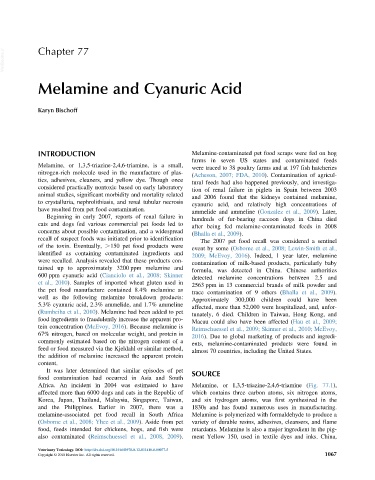Page 1135 - Veterinary Toxicology, Basic and Clinical Principles, 3rd Edition
P. 1135
VetBooks.ir Chapter 77
Melamine and Cyanuric Acid
Karyn Bischoff
INTRODUCTION Melamine-contaminated pet food scraps were fed on hog
farms in seven US states and contaminated feeds
Melamine, or 1,3,5-triazine-2,4,6-triamine, is a small,
were traced to 38 poultry farms and at 197 fish hatcheries
nitrogen-rich molecule used in the manufacture of plas-
(Acheson, 2007; FDA, 2010). Contamination of agricul-
tics, adhesives, cleaners, and yellow dye. Though once
tural feeds had also happened previously, and investiga-
considered practically nontoxic based on early laboratory
tion of renal failure in piglets in Spain between 2003
animal studies, significant morbidity and mortality related
and 2006 found that the kidneys contained melamine,
to crystalluria, nephrolithiasis, and renal tubular necrosis cyanuric acid, and relatively high concentrations of
have resulted from pet food contamination.
ammelide and ammeline (Gonzalez et al., 2009). Later,
Beginning in early 2007, reports of renal failure in
hundreds of fur-bearing raccoon dogs in China died
cats and dogs fed various commercial pet foods led to
after being fed melamine-contaminated feeds in 2008
concerns about possible contamination, and a widespread
(Bhalla et al., 2009).
recall of suspect foods was initiated prior to identification
The 2007 pet food recall was considered a sentinel
of the toxin. Eventually, .150 pet food products were
event by some (Osborne et al., 2008; Lewin-Smith et al.,
identified as containing contaminated ingredients and
2009; McEvoy, 2016). Indeed, 1 year later, melamine
were recalled. Analysis revealed that these products con-
contamination of milk-based products, particularly baby
tained up to approximately 3200 ppm melamine and
formula, was detected in China. Chinese authorities
600 ppm cyanuric acid (Cianciolo et al., 2008; Skinner
detected melamine concentrations between 2.5 and
et al., 2010). Samples of imported wheat gluten used in
2563 ppm in 13 commercial brands of milk powder and
the pet food manufacture contained 8.4% melamine as
trace contamination of 9 others (Bhalla et al., 2009).
well as the following melamine breakdown products:
Approximately 300,000 children could have been
5.3% cyanuric acid, 2.3% ammelide, and 1.7% ammeline
affected, more than 52,000 were hospitalized, and, unfor-
(Rumbeiha et al., 2010). Melamine had been added to pet
tunately, 6 died. Children in Taiwan, Hong Kong, and
food ingredients to fraudulently increase the apparent pro-
Macau could also have been affected (Hau et al., 2009;
tein concentration (McEvoy, 2016). Because melamine is
Reimschuessel et al., 2009; Skinner et al., 2010; McEvoy,
67% nitrogen, based on molecular weight, and protein is
2016). Due to global marketing of products and ingredi-
commonly estimated based on the nitrogen content of a
ents, melamine-contaminated products were found in
feed or food measured via the Kjeldahl or similar method,
almost 70 countries, including the United States.
the addition of melamine increased the apparent protein
content.
It was later determined that similar episodes of pet
SOURCE
food contamination had occurred in Asia and South
Africa. An incident in 2004 was estimated to have Melamine, or 1,3,5-triazine-2,4,6-triamine (Fig. 77.1),
affected more than 6000 dogs and cats in the Republic of which contains three carbon atoms, six nitrogen atoms,
Korea, Japan, Thailand, Malaysia, Singapore, Taiwan, and six hydrogen atoms, was first synthesized in the
and the Philippines. Earlier in 2007, there was a 1830s and has found numerous uses in manufacturing.
melamine-associated pet food recall in South Africa Melamine is polymerized with formaldehyde to produce a
(Osborne et al., 2008; Yhee et al., 2009). Aside from pet variety of durable resins, adhesives, cleansers, and flame
food, feeds intended for chickens, hogs, and fish were retardants. Melamine is also a major ingredient in the pig-
also contaminated (Reimschuessel et al., 2008, 2009). ment Yellow 150, used in textile dyes and inks. China,
Veterinary Toxicology. DOI: http://dx.doi.org/10.1016/B978-0-12-811410-0.00077-5
Copyright © 2018 Elsevier Inc. All rights reserved. 1067

